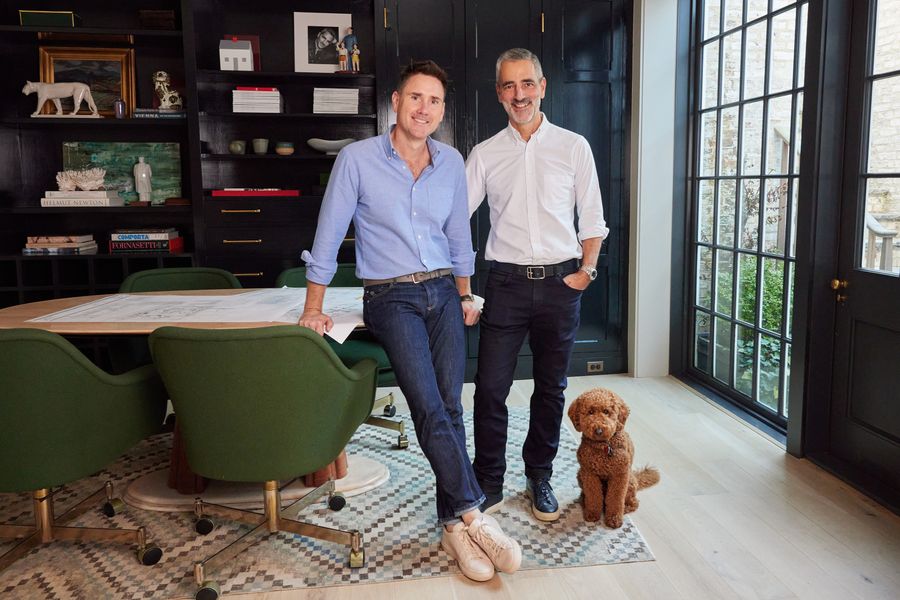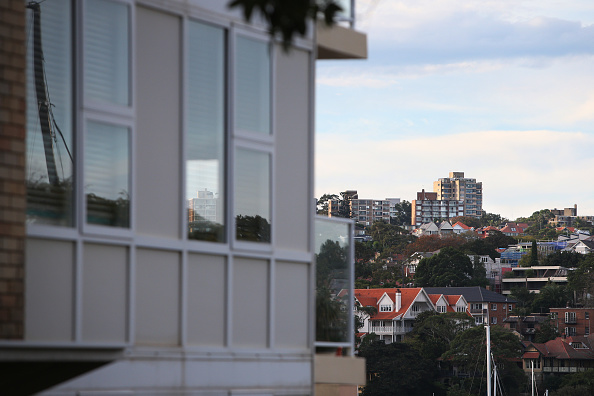They Love Their $14.95 Million Hamptons House. The Problem? Their Dog Hates It
Bryan Graybill and Daniel Dokos built their dream home in Sag Harbor but are now selling it because their goldendoodle Rufus gets “pouty” when he’s there
Shortly after Bryan Graybill and Daniel Dokos moved into their dream home in Sag Harbor, N.Y., in 2022, the couple realized they had a problem: Their beloved Covid dog, a redheaded goldendoodle named Rufus, didn’t like the house.
“He was sort of a little pouty,” said Graybill, an interior designer, who said they adopted Rufus from a dog breeder in Montecito, Calif., where they rode out the pandemic.
Now, the couple is doing what any self-respecting dog parents would do: They are moving.
“I’m slightly ashamed to admit that we’ve become ‘those people,’ making life decisions around our dog,” said Graybill. And yet, he said, “He’s the joy of our life.”
The house is coming on the market for $14.95 million, said Preston Kaye of Hedgerow Exclusive Properties, which is co-listing the property with Noble Black and Erica Grossman of Douglas Elliman . Graybill and Dokos, a lawyer, who also have homes in East Hampton and Montecito, plan to split their time between the two. They also have a place in New York City.
Before Rufus, Graybill said the couple thought the newly built Sag Harbor house would be their “forever home.”
When they got married in 2015, they lived mainly in East Hampton and began building a house there. During construction, they rented a place in Sag Harbor and unexpectedly fell in love with the area and bought property there, too. “It’s sort of a vibrant little town, even in the middle of winter,” Graybill said. They wound up renting out the newly built East Hampton house until recently.
In 2018, they paid $2.65 million for a nearly ½-acre property in Sag Harbor with about 110 feet of frontage on Upper Sag Harbor Cove. Graybill said at the time, the property had a modest, roughly 1,600-square-foot house built in the 1950s.
Graybill said he initially assumed the house would be overly-complicated to renovate because of its proximity to the water. “Buying the property was a roll of the dice,” he said. “We didn’t know how much we could do.”
As it turned out, they could do quite a bit.
Diving into historic research, the couple learned that a stretch of the now-defunct elevated railroad that once ran from Bridgehampton to Sag Harbor crossed a corner of their property, which was also home to a warehouse during the area’s whaling heyday in the 1800s.
With approval from local officials, Graybill and Dokos substantially renovated the 1950s home, building a roughly 4,200-square-foot house with five bedrooms in its footprint. “It required a huge feat of engineering acrobatics to figure it out,” Graybill said. Because the house is set back 12 feet from the water, they were able to add a pool, a pool house and a two-car garage between the house and the street.
Graybill said the property’s original 1880s building inspired him to commission a warehouse-like structure with loading dock doors, high ceilings and open spaces. Part two of the design was to convert the industrial space to a home, using features like interior window walls. Permitting took about three years, and it took another two years to complete construction.
Graybill said despite being smaller than their East Hampton home, which is about 6,500 square feet, the house in Sag Harbor felt “intimate” and had all the amenities they wanted, including a pool, a pool bar and an office that looks west over the cove and north over a marsh and bird sanctuary. Graybill, who trained in London under the late restaurant designer David Collins , said he adopted certain U.K. sensibilities in the Sag Harbor home, such as high-set windows to maximise natural light, and a “boot room” near the front door where visitors can sit and remove their shoes and coats. The large kitchen is a “working” kitchen with pots and pans hanging within reach. “It’s not a relaxation area,” he said. “You’re in the kitchen to cook.”
They spent about $8 million on construction, landscaping and hard and soft costs, Graybill said. “I thought it would be our forever home, so I really leaned into everything being custom.”
Graybill said they “went a little indulgent” on interior finishes like light fixtures, paint, plaster and kitchen appliances, and the windows were made in Charleston, S.C., by a company specialising in historic windows.
The median sale price in Sag Harbor was $1.9 million during the fourth quarter of 2023, down 12% from the prior-year period, according to real-estate appraisal firm Miller Samuel. But sales were up 61.5% year-over-year during the quarter, while inventory rose 16.8% compared with the fourth quarter of 2022.
Graybill said they designed the house before adopting Rufus, so there are no doggy amenities. “Gosh no, and as a result he sleeps in the bed with us and walks freely on whatever furniture he wants,” he said. After a romp on the beach, Rufus also bathes in their tub. (Graybill said part of the decision to move to East Hampton is that the house there has a covered porch where they can put a dog sink.)
Like other pet owners, Graybill and Dokos adopted Rufus during Covid when they were living in Montecito and spending more time at home. “Dan had never had a dog,” said Graybill, who grew up with poodles and lab retrievers and was initially reluctant to get a dog because he knew how much responsibility it would be. “We like our freedom,” he said.
But Graybill said one night as they lay in bed, Dokos texted him a picture of a local breeder’s two golden doodles. “One was William and one was Harry,” he recalled. When they went to see the dogs the next day, Harry—the smaller of the pups—ran right up to Dokos. They brought him home that afternoon and named him Rufus, which means redheaded in Latin. The trio fell into a new routine that included daily jaunts on the beach.
Graybill said when they moved to Sag Harbor, Rufus’ joyful demeanour changed.
They took him to nearby bay beaches, but they were narrow and a bit rocky. “The dog was constrained,” Graybill said. He couldn’t run as fast or as far as he had in California. “He couldn’t dig.”
Graybill said he and Dokos thought Rufus would acclimate until they drove to East Hampton one day and the dog was back in his element. “The smile on his face—if dogs could smile—I said to Dan, ‘I think the dog is happier in East Hampton,’” Graybill said.
Graybill said he has no regrets about deciding to sell the house, in part because he and Dokos enjoyed the building process together. “I’m giving up this life we wanted to build in Sag Harbor,” he said, “but I’m gaining this daily ritual of going to the beach with my husband and dog, and I just really cherish that.”
 Copyright 2020, Dow Jones & Company, Inc. All Rights Reserved Worldwide. LEARN MORE
Copyright 2020, Dow Jones & Company, Inc. All Rights Reserved Worldwide. LEARN MORE
This stylish family home combines a classic palette and finishes with a flexible floorplan
Just 55 minutes from Sydney, make this your creative getaway located in the majestic Hawkesbury region.
Ahead of the Games, a breakdown of the city’s most desirable places to live
PARIS —Paris has long been a byword for luxurious living. The traditional components of the upscale home, from parquet floors to elaborate moldings, have their origins here. Yet settling down in just the right address in this low-rise, high-density city may be the greatest luxury of all.
Tradition reigns supreme in Paris real estate, where certain conditions seem set in stone—the western half of the city, on either side of the Seine, has long been more expensive than the east. But in the fashion world’s capital, parts of the housing market are also subject to shifting fads. In the trendy, hilly northeast, a roving cool factor can send prices in this year’s hip neighborhood rising, while last year’s might seem like a sudden bargain.
This week, with the opening of the Olympic Games and the eyes of the world turned toward Paris, The Wall Street Journal looks at the most expensive and desirable areas in the City of Light.
The Most Expensive Arrondissement: the 6th
Known for historic architecture, elegant apartment houses and bohemian street cred, the 6th Arrondissement is Paris’s answer to Manhattan’s West Village. Like its New York counterpart, the 6th’s starving-artist days are long behind it. But the charm that first wooed notable residents like Gertrude Stein and Jean-Paul Sartre is still largely intact, attracting high-minded tourists and deep-pocketed homeowners who can afford its once-edgy, now serene atmosphere.
Le Breton George V Notaires, a Paris notary with an international clientele, says the 6th consistently holds the title of most expensive arrondissement among Paris’s 20 administrative districts, and 2023 was no exception. Last year, average home prices reached $1,428 a square foot—almost 30% higher than the Paris average of $1,100 a square foot.
According to Meilleurs Agents, the Paris real estate appraisal company, the 6th is also home to three of the city’s five most expensive streets. Rue de Furstemberg, a secluded loop between Boulevard Saint-Germain and the Seine, comes in on top, with average prices of $2,454 a square foot as of March 2024.
For more than two decades, Kyle Branum, a 51-year-old attorney, and Kimberly Branum, a 60-year-old retired CEO, have been regular visitors to Paris, opting for apartment rentals and ultimately an ownership interest in an apartment in the city’s 7th Arrondissement, a sedate Left Bank district known for its discreet atmosphere and plutocratic residents.
“The 7th was the only place we stayed,” says Kimberly, “but we spent most of our time in the 6th.”
In 2022, inspired by the strength of the dollar, the Branums decided to fulfil a longstanding dream of buying in Paris. Working with Paris Property Group, they opted for a 1,465-square-foot, three-bedroom in a building dating to the 17th century on a side street in the 6th Arrondissement. They paid $2.7 million for the unit and then spent just over $1 million on the renovation, working with Franco-American visual artist Monte Laster, who also does interiors.
The couple, who live in Santa Barbara, Calif., plan to spend about three months a year in Paris, hosting children and grandchildren, and cooking after forays to local food markets. Their new kitchen, which includes a French stove from luxury appliance brand Lacanche, is Kimberly’s favourite room, she says.
Another American, investor Ashley Maddox, 49, is also considering relocating.
In 2012, the longtime Paris resident bought a dingy, overstuffed 1,765-square-foot apartment in the 6th and started from scratch. She paid $2.5 million and undertook a gut renovation and building improvements for about $800,000. A centrepiece of the home now is the one-time salon, which was turned into an open-plan kitchen and dining area where Maddox and her three children tend to hang out, American-style. Just outside her door are some of the city’s best-known bakeries and cheesemongers, and she is a short walk from the Jardin du Luxembourg, the Left Bank’s premier green space.
“A lot of the majesty of the city is accessible from here,” she says. “It’s so central, it’s bananas.” Now that two of her children are going away to school, she has listed the four-bedroom apartment with Varenne for $5 million.
The Most Expensive Neighbourhoods: Notre-Dame and Invalides
Garrow Kedigian is moving up in the world of Parisian real estate by heading south of the Seine.
During the pandemic, the Canada-born, New York-based interior designer reassessed his life, he says, and decided “I’m not going to wait any longer to have a pied-à-terre in Paris.”
He originally selected a 1,130-square-foot one-bedroom in the trendy 9th Arrondissement, an up-and-coming Right Bank district just below Montmartre. But he soon realised it was too small for his extended stays, not to mention hosting guests from out of town.
After paying about $1.6 million in 2022 and then investing about $55,000 in new decor, he put the unit up for sale in early 2024 and went house-shopping a second time. He ended up in the Invalides quarter of the 7th Arrondissement in the shadow of one Paris’s signature monuments, the golden-domed Hôtel des Invalides, which dates to the 17th century and is fronted by a grand esplanade.
His new neighbourhood vies for Paris’s most expensive with the Notre-Dame quarter in the 4th Arrondissement, centred on a few islands in the Seine behind its namesake cathedral. According to Le Breton, home prices in the Notre-Dame neighbourhood were $1,818 a square foot in 2023, followed by $1,568 a square foot in Invalides.
After breaking even on his Right Bank one-bedroom, Kedigian paid $2.4 million for his new 1,450-square-foot two-bedroom in a late 19th-century building. It has southern exposures, rounded living-room windows and “gorgeous floors,” he says. Kedigian, who bought the new flat through Junot Fine Properties/Knight Frank, plans to spend up to $435,000 on a renovation that will involve restoring the original 12-foot ceiling height in many of the rooms, as well as rescuing the ceilings’ elaborate stucco detailing. He expects to finish in 2025.
Over in the Notre-Dame neighbourhood, Belles demeures de France/Christie’s recently sold a 2,370-square-foot, four-bedroom home for close to the asking price of about $8.6 million, or about $3,630 a square foot. Listing agent Marie-Hélène Lundgreen says this places the unit near the very top of Paris luxury real estate, where prime homes typically sell between $2,530 and $4,040 a square foot.
The Most Expensive Suburb: Neuilly-sur-Seine
The Boulevard Périphérique, the 22-mile ring road that surrounds Paris and its 20 arrondissements, was once a line in the sand for Parisians, who regarded the French capital’s numerous suburbs as something to drive through on their way to and from vacation. The past few decades have seen waves of gentrification beyond the city’s borders, upgrading humble or industrial districts to the north and east into prime residential areas. And it has turned Neuilly-sur-Seine, just northwest of the city, into a luxury compound of first resort.
In 2023, Neuilly’s average home price of $1,092 a square foot made the leafy, stately community Paris’s most expensive suburb.
Longtime residents, Alain and Michèle Bigio, decided this year is the right time to list their 7,730-square-foot, four-bedroom townhouse on a gated Neuilly street.
The couple, now in their mid 70s, completed the home in 1990, two years after they purchased a small parcel of garden from the owners next door for an undisclosed amount. Having relocated from a white-marble château outside Paris, the couple echoed their previous home by using white- and cream-coloured stone in the new four-story build. The Bigios, who will relocate just back over the border in the 16th Arrondissement, have listed the property with Emile Garcin Propriétés for $14.7 million.
The couple raised two adult children here and undertook upgrades in their empty-nester years—most recently, an indoor pool in the basement and a new elevator.
The cool, pale interiors give way to dark and sardonic images in the former staff’s quarters in the basement where Alain works on his hobby—surreal and satirical paintings, whose risqué content means that his wife prefers they stay downstairs. “I’m not a painter,” he says. “But I paint.”
The Trendiest Arrondissement: the 9th
French interior designer Julie Hamon is theatre royalty. Her grandfather was playwright Jean Anouilh, a giant of 20th-century French literature, and her sister is actress Gwendoline Hamon. The 52-year-old, who divides her time between Paris and the U.K., still remembers when the city’s 9th Arrondissement, where she and her husband bought their 1,885-square-foot duplex in 2017, was a place to have fun rather than put down roots. Now, the 9th is the place to do both.
The 9th, a largely 19th-century district, is Paris at its most urban. But what it lacks in parks and other green spaces, it makes up with nightlife and a bustling street life. Among Paris’s gentrifying districts, which have been transformed since 2000 from near-slums to the brink of luxury, the 9th has emerged as the clear winner. According to Le Breton, average 2023 home prices here were $1,062 a square foot, while its nearest competitors for the cool crown, the 10th and the 11th, have yet to break $1,011 a square foot.
A co-principal in the Bobo Design Studio, Hamon—whose gut renovation includes a dramatic skylight, a home cinema and air conditioning—still seems surprised at how far her arrondissement has come. “The 9th used to be well known for all the theatres, nightclubs and strip clubs,” she says. “But it was never a place where you wanted to live—now it’s the place to be.”
With their youngest child about to go to college, she and her husband, 52-year-old entrepreneur Guillaume Clignet, decided to list their Paris home for $3.45 million and live in London full-time. Propriétés Parisiennes/Sotheby’s is handling the listing, which has just gone into contract after about six months on the market.
The 9th’s music venues were a draw for 44-year-old American musician and piano dealer, Ronen Segev, who divides his time between Miami and a 1,725-square-foot, two-bedroom in the lower reaches of the arrondissement. Aided by Paris Property Group, Segev purchased the apartment at auction during the pandemic, sight unseen, for $1.69 million. He spent $270,000 on a renovation, knocking down a wall to make a larger salon suitable for home concerts.
During the Olympics, Segev is renting out the space for about $22,850 a week to attendees of the Games. Otherwise, he prefers longer-term sublets to visiting musicians for $32,700 a month.
Most Exclusive Address: Avenue Junot
Hidden in the hilly expanses of the 18th Arrondissement lies a legendary street that, for those in the know, is the city’s most exclusive address. Avenue Junot, a bucolic tree-lined lane, is a fairy-tale version of the city, separate from the gritty bustle that surrounds it.
Homes here rarely come up for sale, and, when they do, they tend to be off-market, or sold before they can be listed. Martine Kuperfis—whose Paris-based Junot Group real-estate company is named for the street—says the most expensive units here are penthouses with views over the whole of the city.
In 2021, her agency sold a 3,230-square-foot triplex apartment, with a 1,400-square-foot terrace, for $8.5 million. At about $2,630 a square foot, that is three times the current average price in the whole of the 18th.
Among its current Junot listings is a 1930s 1,220-square-foot townhouse on the avenue’s cobblestone extension, with an asking price of $2.8 million.
This stylish family home combines a classic palette and finishes with a flexible floorplan
Just 55 minutes from Sydney, make this your creative getaway located in the majestic Hawkesbury region.






















